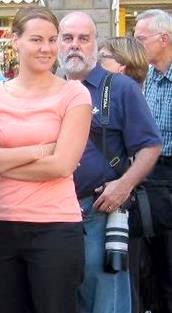Travel &
Vacation Images
Camera Kit
(What I Take On Extended Trips)
I’ve now assembled nearly the perfect traveling kit (all equipment is Canon):
5D digital
back (Plus batteries, filters, storage media, etc.) A portion of this (barely) fits in my Tamrac
“Explorer 3” shoulder bag, and, although very heavy (about 11 pounds), the
combination has now proven itself during our seventeen day trip across northern The Canon 5D is now my standard camera. Virtually all photos are taken in Canon RAW format. I find that 6 GB of storage media are barely sufficient for a two week trip; to be sure I also always carry a 60GB iPod to which I upload the CF cards. The 28-70mm f/2.8 has some of the finest optics of any lens, including most even of fixed focal length. I carry it for low light situations and those requiring the superb optics. Its limited telephoto capabilities mean it is usually secondary in usage to the 28-300mm. (For some trips, however, or when carrying a backpack, I will substitute the EF 17-35mm f/2.8 “L” USM lens in order to add greater wide-angle capability.) The 17-35mm f/2.8 lens provides true wide-angle photography for the 5D, which is a full-frame sensor camera, so it will be packed in the larger Tamrac backpack. If I'm carrying the 70-300mm DO lens, it is small enough that I can put both the 17-35mm and 28-70mm "L" lenses in the shoulder bag as well. |
Commentators have offered mixed reviews of the new (as of May 2004) Canon EF 28-300mm f/3.5-5.6 lens. Some say its push-pull design contributes to greater dust on sensors, but my experience (and the fact that the lens’s rear element is tightly sealed) argues against this criticism. Some find its optics to be deficient, but while this is true when compared to other “L” lenses of more constricted focal length, my experience on this trip has shown that for shots virtually throughout the f-stop range, and particularly at f/8 and f/9.5, photos are blessed by crystalline clarity. An additional powerful benefit derives from Canon’s image stabilization technology, which enabled rock-solid photos even under conditions such as a full 300mm at 1/45 second. In sum, after seeing the results from over 700 photos taken on the Italy trip, I am extremely pleased with the lens’s output. (A footnote: the 28-300mm "L" IS lens is huge! and heavy! [See photo below of me -- and daughter Emily -- with the camera/lens slung over my shoulder.] Total of camera and lens comes in at nearly five pounds. It is hard to photograph with it unobtrusively, except from a distance. But its weight actually serves as an impediment to theft. A street thief just cannot grab it and run -- it has too great an inertia!) If I know I'm going to be lugging equipment during the day, I will take the Canon EF 70-300 f/4.5-5.6 DO lens instead of the 28-300mm. It is considerably lighter and more compact than the 28-300 lens, making for less obtrusive photography. The optics are quite good, although slightly deficient compared to "L"-quality glass I bring the 50mm for extremely low-light situations. It has proven to be quite advantageous in a number of nighttime and natural light interior circumstances. Finally, for rare use, the EX550 strobe
is mandatory, since the 5D has no internal strobe. |
 Photo by Mark Co |